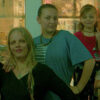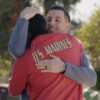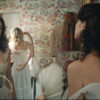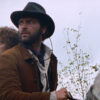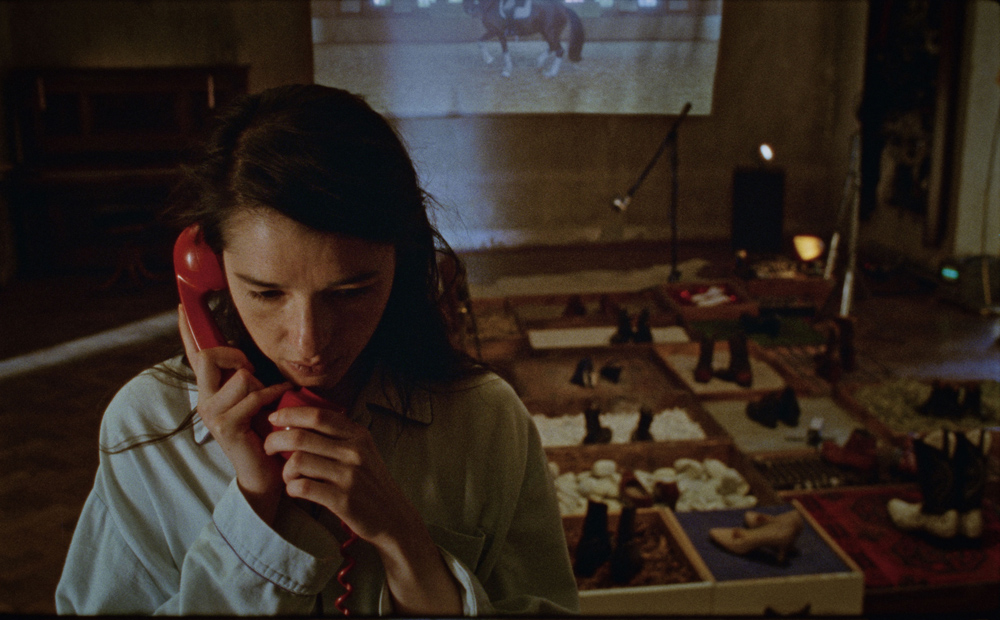In a sign of things to come in the marvelous feature debut of Ann Oren, “Piaffe” starts with a dare when Eva (Simone Bucio) is called in by the director of a commercial for a mood stabilizer, displeased with the sound effects she’s created for the ad featuring a gloomy horse. She’s got reason to be as distraught as the equine when the reason she’s taken on the gig as a Foley artist is because her sibling Zara (Simon Jaikiriuma Paetau) isn’t up to the task, recently committing themselves to treatment, but so intent on trying to appease the director, she takes the form of the horse in other ways, throwing herself into a full-on transformation that involves clopping around in tap shoes and gnawing on a gold chain to get just the right sound of a horse chewing. One can’t necessarily tell the difference in quality when she offers up a second pass at the prescription drug ad, but the personal awakening she’s had as a result of the assignment is undeniable, no longer seeing herself as a different species from the other living organisms she studies.
Oren, who came to film as an accomplished visual artist, finds great pleasure in breaking through formal conceits as readily as her lead character starts breaking down the barriers with other walks of life, as Eva is drawn to a botanist (Sebastian Rudolph) she meets as she’s sourcing sounds out in the field and beyond the animal instincts she’s developed, the blossoming of flora around her encapsulates the sexual awakening taking hold better than any other feeling she’s had as a human. “Piaffe” redefines what’s natural when Oren makes brilliant use of perspective and sound to reorient its audience towards what they should be attuned to when the world comes alive around Eva and she no longer feels held back by conventional wisdom from following her desires. It becomes just as easy to surrender to “Piaffe,” which has enchanted audiences from Locarno to San Sebastián and arrives on U.S. shores this week in theaters and while in New York where the film is opening at the Quad, Oren spoke about how she became enamored of the work of Foley artists, finding truly sensational expressions of life unfolding right before our eyes and working with Bucio.
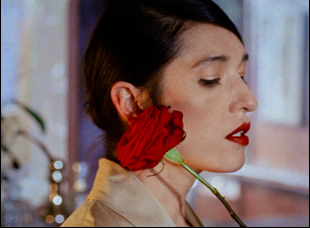
Absolutely. I’ve been waiting for many years to be awakened by an idea for a film, not just a narrative, but the idea of how to make it in a way that I could create a language where I have a place to add something that is not something that I feel like I’ve seen before. And the idea [for “Piaffe”] was to make a film about a foley artist who creates sounds for a horse and then grows into a horse. And I knew that because she’s a Foley artist, I have to use sound as a chief storytelling tool. So I wanted to get a lot of sounds that would creep under your skin so that the character is going through a transformation and you as the viewer, you can fill this transformation together with her, then in different ways to play with the sound to give the viewer the feeling of what it is to be a foley artist, because all day long you’re building a sound from scratch, layer by layer by layer, and then you go out to the street and it’s so loud because in the studio the sound is so controlled. You go to the street, it’s so loud, and then the sound doesn’t match the picture always and you don’t know where it’s coming from, so things like this were really interesting to play with.
Your earlier film “Passage” actually has the same starting point of a foley artist, played by Simon[e] Jaikiriuma Paetau, who now appears as Eva’s sibling. Did you know how this could evolve from the short?
I started writing “Piaffe” a few years ago and because I have a background as a visual artist, it was a bit different. I didn’t know how to go about getting a feature film produced or convincing people to work with me [especially] with the very wild proposition of a film where my background is a visual artist. So I started writing it and I did a lot of research on foley artists, on women and horses, on dressage, and just a fear of submission that I see in this world. And it took a very long time to make it happen, but at some point I had some visual compositions in my head, and I thought I don’t see this film happening, so I decided to make a an audio visual work that would be more like an art installation. I didn’t plan it so much as a short film at first, but [an opportunity to] play with some of the audio visual concepts that I want and this is how “Passage” came about and [it really coalsced] in the post-production because we didn’t record any sound for this film, but in the post-production with the sound designer, I established the language of the sound that later you [hear] in “Piaffe” and when “Piaffe” came about, I knew how to go back from the beginning and to record things the way that it happened. I also realized when casting “Piaffe” that the performer [Simon[e]] in “Passage,” I realized that this performer needs to be Zara, so it’s like a prequel.
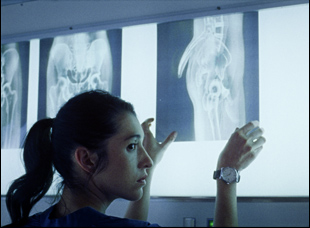
The whole film was cast except for this role and already, the ball was rolling [on the production]. I think casting is very intuitive, and when the right person comes for a role, you feel it, but no one felt right [for this part]. And because we shot in Germany, I was looking for actors in the German-speaking countries and I couldn’t find anybody. Then we went to a casting director for a broader search and she suggested people. When I saw Simone’s headshots, I said, “Okay, she’s very mysterious looking” and she’s Mexican, but she spent some time in Berlin. She was in the film “The Untamed,” which was great. And then we met and what really sold me on her is that when I gave her the script to read, she had like a really profound understanding of the character. The questions she had and the ideas [about it], I saw that she’s really understands the material. It’s not something that every actress would connect with. And then we did an audition and it was super clear that it’s her. She brought so much into the character and she was so open and experimental, and she fell into the role very intuitively.
What went into designing her apartment? It seems like it must’ve been really helpful to her performance.
We found this Altbau apartment in Berlin that has the basic structure and the walls, and it was a suitable setup for what I had in mind. It was very important for me that she’s working at home. She gets out of bed and immediately she’s in the work studio. And for all kinds of freelancers, [there’s] this lack of separation between work and life that I felt was very important [to depict]. Originally, I was inspired by this apartment I was once in in Leipzig, and it had a lot of old furniture and everything was squeaky wooden and that gave me the inspiration for this particular apartment and also adding all the gear that has to go with in a full studio.
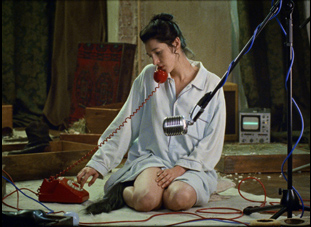
The botanical gardens were definitely my dream location for the scene. A fern greenhouse like this is not something you can build, especially the tree ferns that are huge there. So I imagined all these scenes there and because we were shooting during [COVID], only at the last minute we got the green light to shoot there because it’s an institution and they had a lot of bureaucracy, but that was a very important [location] and I was so happy that we got to shoot there. And the Hufa, it’s a horseshoe colony in Berlin. I was actually looking at another colony building structure in Berlin that was not suitable [but wondered] what other kind of colonies you have in Berlin. And I realized, “There’s the horseshoe colony. I have to go see it right now.” And I went there and immediately, I said to the producers, “We have to shoot there,” and no films were shot there. We had to [film] with the drone because otherwise you don’t see that it’s shaped like a horseshoe [from above], but it was one of the exciting discoveries during scouting.
That creates a transition between scenes that was just breathtaking to me.
It’s my favorite too.
What was it actually like working with the horse? It really gave a performance.
It’s a little horse. It’s not a stunt horse, and the horse and the rider come as a duo — they’re like sports partners, so we were counting a lot on [the rider] and [the horse] was well behaved. I think when you work with animals you have to be a little bit flexible. I have very clear ideas of what I want in most cases, but when you’re working with animals you have to see what you get and somehow work around it. We planned some things, but it’s a little bit improvised because it’s an animal and it’s very big, so sometimes it’s hard to catch the nuances. It was well-behaved and in some locations, we had a horse double because you’re changing locations and they don’t know whether to move it, [and the horse we had] was not used to having lights around him and camera and people, but it was really interesting experience.
It sounds like it took patience, as does the time-lapse footage of plant life you captured in the film. Was that an interesting process?
Some of it we shot and some was found footage that we manipulated, and some of it [was] made to look like it’s inside of the photoplasticon on slides that is coming to life. I’m currently really obsessed with time-lapse photography of living things that are not non-human, so it was very exciting. And when you do the time-lapse, you see the growth movement and I’m always trying to look at desire within other species. This is one way of doing it. If you look at the movement with desire, they’re moving towards the light usually, and I’m very fascinated with that.
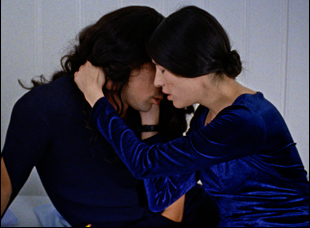
First of all, we have the reference to Edward Muybridge and the horse is one of the first animal used for the experiments of image and motion before cinema, so there was that, and then I wanted above all the film to really communicate with the body of the viewer. I want it to be a visceral film and I know that there is something in the film grain that brings this across that you cannot do with video. I’ve done a lot of videos and I know what it’s wonderful for, but not if you’re trying to really get a [tactile quality] — I wanted almost the viewers to be able to touch what they’re seeing with their eyes and also a visceral quality that complements what Foley does. Also, I knew that I’m going to have light leaks, and the end of [celluloid] rolls sometimes at the end of takes, and sometimes you see these red or yellow flares and [I could] use it dramatically to express or nostalgia or ecstasy or something that the character is going through really from the material on which it is captured. And when you’re shooting on film, people know that you cannot do so many takes because you’re burning material every time that you do, so there is this underlined excitement for everybody on set when you’re rolling and this is something really, really precious that really changes the result of what you’re getting as well.
The results are up there on screen. What’s it been like for you this past year getting this out into the world?
It’s so gratifying. it’s really hard work to get a film made. This was four years in the making, and it was the biggest production I’ve done. It was in so many film festivals and I’ve traveled a lot with it and after putting so much of myself into the film — and of course, I make it with the team, so when you go and create a discussion on the narrative that came out of it with other people, they bring their own baggage into it and you see what people were moved by in ways that I didn’t expect, it becomes something much larger than us. It’s really surprising and very motivating to go on and make another film.
“Piaffe” opens on August 25th in New York at the Quad Cinema, September 1st in Tulsa at the Circle Cinema and Dallas at the Texas Theatre and September 15th in Los Angeles at the Nuart Theatre. A full list of theaters and dates is here.
